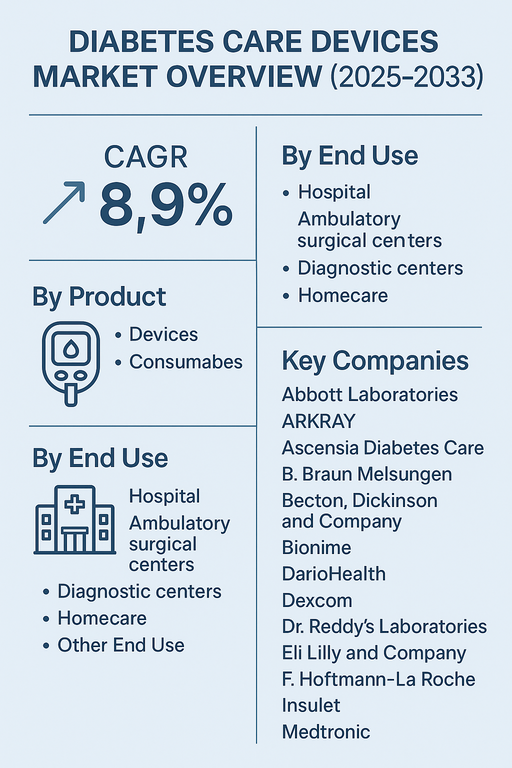The global diabetes care devices market is projected to expand at a CAGR of 12.3% from 2025 to 2033, driven by the increasing prevalence of diabetes, rising healthcare expenditure, and growing demand for advanced monitoring and insulin delivery solutions. Diabetes care devices, covering both monitoring systems and consumables, play a vital role in improving disease management, preventing complications, and enhancing patient quality of life. With more than 530 million people affected globally by diabetes and the figure expected to rise, adoption of technologically advanced devices such as continuous glucose monitoring (CGM) systems, smart insulin pens, and automated insulin delivery systems is accelerating across regions.

Growing Diabetes Burden and Technological Advancements Driving Growth
The global diabetes epidemic is the primary driver of market expansion, particularly in emerging economies experiencing lifestyle shifts, urbanization, and increasing obesity rates. Demand is strongly supported by government health programs, patient education initiatives, and greater accessibility to advanced devices. Continuous glucose monitoring and flash glucose monitoring systems are gaining rapid adoption due to real-time data insights, integration with mobile apps, and improved patient compliance. Insulin pumps and connected devices are reshaping care delivery by reducing dependence on manual monitoring and providing automated dosage adjustment. Innovations in AI-based analytics and closed-loop systems, also known as “artificial pancreas” solutions, are advancing diabetes care toward personalized treatment.
Challenges: High Costs and Access Barriers
Despite strong growth drivers, the market faces barriers such as high costs of insulin pumps, CGM systems, and consumables, which limit widespread adoption, especially in developing countries. Reimbursement limitations and unequal access to advanced devices across healthcare systems remain significant challenges. Patient compliance with device usage and data interpretation can also be difficult, particularly among elderly populations. Additionally, data privacy and cybersecurity risks associated with connected diabetes devices require ongoing mitigation. Nevertheless, efforts to expand reimbursement, develop cost-effective alternatives, and integrate digital health platforms are creating pathways for broader accessibility.
Market Segmentation by Product
By product, the diabetes care devices market is categorized into devices and consumables. Devices include glucose meters, insulin pumps, continuous glucose monitoring systems, and insulin pens. This segment accounted for the larger market share in 2024, driven by innovations in smart connected solutions and real-time glucose tracking. Consumables, including test strips, lancets, and sensors, are essential recurring revenue drivers for manufacturers, ensuring steady growth alongside device adoption. Continuous advancements in sensor accuracy and extended wear times are strengthening the consumables segment further.
Market Segmentation by End Use
By end use, the market is segmented into hospitals, ambulatory surgical centers, diagnostic centers, homecare, and other end use. In 2024, hospitals dominated the market, supported by large patient bases and advanced treatment infrastructure. Homecare settings are the fastest-growing segment, driven by the rise of remote monitoring, self-testing, and patient preference for convenient diabetes management. Diagnostic centers continue to support demand for routine testing, while ambulatory surgical centers represent a smaller but growing segment for specialized diabetes-related procedures.
Regional Insights
In 2024, North America led the diabetes care devices market, supported by high diabetes prevalence, strong reimbursement policies, and robust adoption of advanced insulin delivery systems. Europe followed closely, with strong growth in Germany, the UK, and France driven by national health initiatives and high consumer awareness. Asia Pacific is the fastest-growing region, with China and India contributing significantly due to large diabetic populations, rising healthcare expenditure, and improving access to advanced technologies. Latin America and Middle East & Africa (MEA) are emerging markets where rising incidence of diabetes, combined with urbanization and government-backed awareness programs, are opening growth opportunities despite cost and infrastructure limitations.
Competitive Landscape
The 2024 market was marked by strong competition among global leaders and regional players. Abbott Laboratories, Dexcom, and Medtronic led the market with advanced CGM systems and insulin delivery platforms. F. Hoffmann-La Roche, Ascensia Diabetes Care, and LifeScan remain dominant in the blood glucose monitoring segment. Novo Nordisk, Eli Lilly, and Sanofi maintained leadership in insulin delivery and injectables while expanding into connected device ecosystems. Insulet, Tandem Diabetes Care, and Ypsomed Holding are innovating in wearable insulin pumps and patch technologies. Companies like ARKRAY, Sinocare, Bionime, and Nova Biomedical strengthen presence in cost-sensitive markets with glucose meters and consumables. Niche innovators such as Pendiq and DarioHealth focus on smart pens and app-based platforms for personalized diabetes care. Competitive differentiation is defined by accuracy, affordability, digital integration, and ecosystem partnerships with healthcare providers and telehealth platforms.
Historical & Forecast Period
This study report represents analysis of each segment from 2023 to 2033 considering 2024 as the base year. Compounded Annual Growth Rate (CAGR) for each of the respective segments estimated for the forecast period of 2025 to 2033.
The current report comprises of quantitative market estimations for each micro market for every geographical region and qualitative market analysis such as micro and macro environment analysis, market trends, competitive intelligence, segment analysis, porters five force model, top winning strategies, top investment markets, emerging trends and technological analysis, case studies, strategic conclusions and recommendations and other key market insights.
Research Methodology
The complete research study was conducted in three phases, namely: secondary research, primary research, and expert panel review. key data point that enables the estimation of Diabetes Care Devices market are as follows:
Market forecast was performed through proprietary software that analyzes various qualitative and quantitative factors. Growth rate and CAGR were estimated through intensive secondary and primary research. Data triangulation across various data points provides accuracy across various analyzed market segments in the report. Application of both top down and bottom-up approach for validation of market estimation assures logical, methodical and mathematical consistency of the quantitative data.
| ATTRIBUTE | DETAILS |
|---|---|
| Research Period | 2023-2033 |
| Base Year | 2024 |
| Forecast Period | 2025-2033 |
| Historical Year | 2023 |
| Unit | USD Million |
| Segmentation | |
Product
| |
End Use
| |
|
Region Segment (2023-2033; US$ Million)
|
Key questions answered in this report